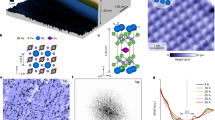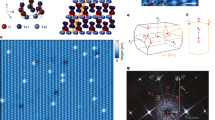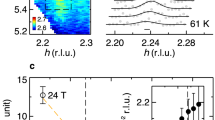Abstract
The interplay of magnetic and charge fluctuations can lead to quantum phases with exceptional electronic properties. A case in point is magnetically-driven superconductivity1,2, where magnetic correlations fundamentally affect the underlying symmetry and generate new physical properties. The superconducting wavefunction in most known magnetic superconductors does not break translational symmetry. However, it has been predicted that modulated triplet p-wave superconductivity occurs in singlet d-wave superconductors with spin-density-wave (SDW) order3,4. Here we report evidence for the presence of a spatially inhomogeneous p-wave Cooper pair-density wave in CeCoIn5. We show that the SDW domains can be switched completely by a tiny change of the magnetic field direction, which is naturally explained by the presence of triplet superconductivity. Further, the Q-phase emerges in a common magneto-superconducting quantum critical point. The Q-phase of CeCoIn5 thus represents an example where spatially modulated superconductivity is associated with SDW order.
This is a preview of subscription content, access via your institution
Access options
Subscribe to this journal
Receive 12 print issues and online access
$259.00 per year
only $21.58 per issue
Buy this article
- Purchase on SpringerLink
- Instant access to full article PDF
Prices may be subject to local taxes which are calculated during checkout




Similar content being viewed by others
References
Mathur, N. D. et al. Magnetically mediated superconductivity in heavy fermion compounds. Nature 394, 39–43 (1998).
Monthoux, P., Pines, D. & Lonzarich, G. G. Superconductivity without phonons. Nature 450, 1177–1183 (2007).
Aperis, A., Varelogiannis, G. & Littlewood, P. B. Magnetic-field-induced pattern of coexisting condensates in the superconducting state of CeCoIn5 . Phys. Rev. Lett. 104, 216403 (2010).
Agterberg, D. F., Sigrist, M. & Tsunetsugu, H. Order parameter and vortices in the superconducting Q phase of CeCoIn5 . Phys. Rev. Lett. 102, 207004 (2009).
Norman, M. R. The challenge of unconventional superconductivity. Science 332, 196–200 (2011).
Sigrist, M. & Ueda, K. Phenomenological theory of unconventional superconductivity. Rev. Mod. Phys. 63, 239–311 (1991).
Mackenzie, A. P. & Maeno, Y. The superconductivity of Sr2RuO4 and the physics of spin-triplet pairing. Rev. Mod. Phys. 75, 657–712 (2003).
Petrovic, C. et al. Heavy-fermion superconductivity in CeCoIn5 at 2.3 K. J. Phys. Condens. Matter 13, L337–L342 (2001).
Thompson, J. D. & Fisk, Z. Progress in heavy-fermion superconductivity: Ce115 and related materials. J. Phys. Soc. Jpn 81, 011002 (2012).
Movshovich, R. et al. Unconventional superconductivity in CeIrIn5 and CeCoIn5: Specific heat and thermal conductivity studies. Phys. Rev. Lett. 86, 5152–5155 (2001).
Izawa, K. et al. Angular position of nodes in the superconducting gap of quasi-2D heavy-fermion superconductor CeCoIn5 . Phys. Rev. Lett. 87, 057002 (2001).
Curro, N. J. et al. Anomalous NMR magnetic shifts in CeCoIn5 . Phys. Rev. B 64, 180514(R) (2001).
Settai, R. et al. Quasi-two-dimensional Fermi surfaces and the de Haas-van Alphen oscillation in both the normal and the superconducting mixed states of CeCoIn5 . J. Phys. Condens. Matter 13, L627–L634 (2001).
Stock, C., Brohom, C., Hudis, J., Kang, H. J. & Petrovic, C. Spin resonance in the d-wave superconductor CeCoIn5 . Phys. Rev. Lett. 100, 087001 (2008).
Bianchi, A., Movshovich, R., Capan, C., Pagliuso, P. G. & Sarrao, J. L. Possible Fulde–Ferrell–Larkin–Ovchinnikov state in CeCoIn5 . Phys. Rev. Lett. 91, 187004 (2003).
Kenzelmann, M. et al. Coupled superconducting and magnetic order in CeCoIn5 . Science 312, 1652–1654 (2008).
Kenzelmann, M. et al. Evidence for a magnetically driven superconducting Q phase of CeCoIn5 . Phys. Rev. Lett. 104, 127001 (2010).
Young, B.-L. et al. Microscopic evidence for field-induced magnetism in CeCoIn5 . Phys. Rev. Lett. 98, 036402 (2007).
Yanase, Y. & Sigrist, M. Ginzburg–Landau analysis for the antiferromagnetic order in the Fulde–Ferrell–Larkin–Ovchinnikov superconductor. J. Phys. Soc. Jpn 80, 094702 (2011).
Suzuki, K. M., Ichioka, M. & Machida, K. Theory of an inherent spin-density-wave instability due to vortices in superconductors with strong Pauli effects. Phys. Rev. B 83, 140503(R) (2011).
Kato, Y., Batista, C. D. & Vekhter, I. Antiferromagnetic order in Pauli-limited unconventional superconductors. Phys. Rev. Lett. 107, 096401 (2011).
Koutroulakis, G. et al. Field evolution of coexisting superconducting and magnetic orders in CeCoIn5 . Phys. Rev. Lett. 104, 087001 (2010).
Leggett, A. J. A theoretical description of the new phases of liquid 3He. Rev. Mod. Phys. 47, 331–414 (1975).
Kumagai, K., Shishido, H., Shibauchi, T. & Matsuda, Y. Evolution of paramagnetic quasiparticle excitations emerged in the high-field superconducting phase of CeCoIn5 . Phys. Rev. Lett. 106, 137004 (2011).
Mitrović, V. F. et al. Observation of spin susceptibility enhancement in the possible Fulde–Ferrell–Larkin–Ovchinnikov state of CeCoIn5 . Phys. Rev. Lett. 97, 117002 (2006).
Tokiwa, Y., Bauer, E. D. & Gegenwart, P. Quasiparticle entropy in the high-field superconducting phase of CeCoIn5 . Phys. Rev. Lett. 109, 116402 (2012).
Ronning, F. et al. Field-tuned quantum critical point in CeCoIn5 near the superconducting upper critical field. Phys. Rev. B 71, 104528 (2005).
Bianchi, A., Movshovich, R., Vekther, I., Pagliuso, P. G. & Sarrao, J. L. Avoided antiferromagnetic order and quantum critical point in CeCoIn5 . Phys. Rev. Lett. 91, 257001 (2003).
Paglione, J. et al. Field-Induced quantum critical point in CeCoIn5 . Phys. Rev. Lett. 91, 246405 (2003).
Tanatar, M. A., Paglione, J., Petrovic, C. & Taillefer, L. Anisotropic violation of the Wiedemann–Franz law at a quantum critical point. Science 316, 1320–1322 (2007).
Acknowledgements
This work is based on neutron scattering experiments performed at the Institut Laue-Langevin, Grenoble, France and the Swiss Spallation Neutron Source SINQ, Paul Scherrer Institute, Villigen, Switzerland. We thank P. Fouilloux and M. Zolliker for technical assistance. Discussions with M. Sigrist as well as C. Batista, P. Coleman, K. Machida, K. Kumagai and J. S. White are acknowledged. This work was supported by the Swiss NSF (Contract No. 200021-122054, 200020-140345 and MaNEP). A.D.B. received support from NSERC, FQRNT and the Canada Research Chair Foundation. Work at LANL was performed under the auspices of the US DOE, Office of Basic Energy Sciences, Division of Materials Sciences and Engineering.
Author information
Authors and Affiliations
Contributions
S.G. and M.K. conceived and led the project. S.G., M.B., J.L.G., E.R., N.E., C.N. and M.K. carried out the experiments. M.B. incorporated the piezoelectric sample rotator into the set-up. E.D.B and J.D.T. grew and characterized the CeCoIn5 single-crystal. S.G. analysed the data. S.G., J.L.G. and M.K. wrote the manuscript with input from all co-authors.
Corresponding author
Ethics declarations
Competing interests
The authors declare no competing financial interests.
Supplementary information
Supplementary Information
Supplementary Information (PDF 538 kb)
Rights and permissions
About this article
Cite this article
Gerber, S., Bartkowiak, M., Gavilano, J. et al. Switching of magnetic domains reveals spatially inhomogeneous superconductivity. Nature Phys 10, 126–129 (2014). https://doi.org/10.1038/nphys2833
Received:
Accepted:
Published:
Issue date:
DOI: https://doi.org/10.1038/nphys2833
This article is cited by
-
Single-domain stripe order in a high-temperature superconductor
Communications Physics (2022)
-
Nature of the spin resonance mode in CeCoIn5
Communications Physics (2020)
-
Distinct domain switching in Nd0.05Ce0.95CoIn5 at low and high fields
Scientific Reports (2018)
-
Fulde–Ferrell State in Spin–Orbit-Coupled Superconductor: Application to Dresselhaus SOC
Journal of Low Temperature Physics (2018)
-
Robust upward dispersion of the neutron spin resonance in the heavy fermion superconductor Ce1−xYbxCoIn5
Nature Communications (2016)



